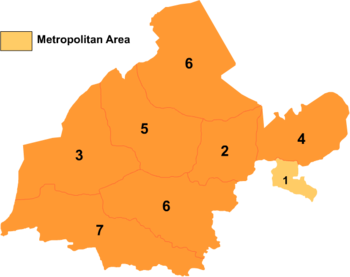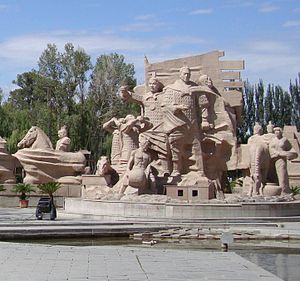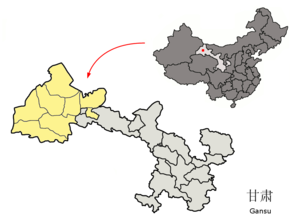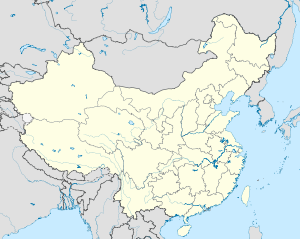- Jiuquan
-
Jiuquan — Prefecture-level city — 酒泉市 Jiuquan Park Location of Jiuquan Prefecture (shaded in yellow) within Gansu Location of Jiuquan Prefecture (shaded in yellow) within Gansu Coordinates: 39°46′N 98°34′E / 39.767°N 98.567°ECoordinates: 39°46′N 98°34′E / 39.767°N 98.567°E Country China Province Gansu Area – Total 191,342 km2 (73,877.6 sq mi) Population (2002) – Total 962,000 – Density 5/km2 (13/sq mi) Time zone China standard time (UTC+8) Website http://www.jiuquan.gov.cn/ Jiuquan (Chinese: 酒泉; pinyin: Jiǔquán) is a "prefecture-level city" in the westernmost part of the Gansu province in China. It is the largest city in the world by area.
Contents
History
The entire "prefecture-level city" (that is, a multi-county administrative unit - an equivalent to the traditional Chinese prefecture) stretches for more than 500 km from east to west, occupying 191,342 km²; its population as of 2002 was 962,000.
The city's name came from legendary tale of the young Han general Huo Qubing, who poured a jar of precious wine into a local creek in order to share the taste with his troops, in celebration of their crushing victory against Xiongnu forces. The creek was later named Jiu Quan ("Wine Spring"), which became the name of the Han prefecture established there. It was an active military garrison during the Later Han Dynasty.[1]
It is known in popular legend as the place where rhubarb was first grown and is also the town where the Portuguese Jesuit missionary and explorer Bento de Góis (1562–1607) was robbed and died destitute.[2]
Administrative divisions
Map 
# Name Hanzi Hanyu Pinyin Population
(2004 est.)Area (km²) Density
(/km²)1 Suzhou District 肃州区 Sùzhōu Qū 350,000 3,349 105 2 Yumen City 玉门市 Yùmén Shì 170,000 13,500 13 3 Dunhuang City 敦煌市 Dūnhuáng Shì 140,000 26,960 5 4 Jinta County 金塔县 Jīntǎ Xiàn 140,000 14,663 9 5 Guazhou County 瓜州县 Guāzhōu Xiàn 90,000 21,350 4 6 Subei Mongol Autonomous County 肃北蒙古族
自治县Sùběi Měnggǔzú
Zìzhìxiàn10,000 55,000 <1 7 Aksai Kazakh Autonomous County 阿克塞哈萨克族
自治县Ākèsài Hāsàkèzú
Zìzhìxiàn10,000 31,374 <1 Geography
Jiuquan has a cold desert climate (Koppen BWk), with long, cold winters, and hot, somewhat dry summers. Monthly average temperatures range from −9 °C (15.8 °F) in January to 21.7 °C (71.1 °F) in July, with an annual mean of 7.5 °C (45.5 °F). The range between daytime and nighttime temperatures is high throughout much of the year. With sunny weather and low humidity dominating year-round, the area hosts one of the launch sites for the PRC's space programme.
Climate data for Jiuquan (1971−2000) Month Jan Feb Mar Apr May Jun Jul Aug Sep Oct Nov Dec Year Average high °C (°F) −1.6
(29.1)2.3
(36.1)9.1
(48.4)17.4
(63.3)23.2
(73.8)26.8
(80.2)28.6
(83.5)27.8
(82.0)22.7
(72.9)15.3
(59.5)6.5
(43.7)−0.1
(31.8)14.8 Average low °C (°F) −14.9
(5.2)−11.3
(11.7)−4.4
(24.1)2.8
(37.0)8.4
(47.1)12.7
(54.9)14.7
(58.5)13.4
(56.1)8.2
(46.8)1.2
(34.2)−6.1
(21.0)−12.6
(9.3)1.0 Precipitation mm (inches) 1.2
(0.047)1.4
(0.055)4.8
(0.189)3.7
(0.146)7.9
(0.311)14.8
(0.583)20.5
(0.807)19.7
(0.776)8.8
(0.346)2.3
(0.091)1.6
(0.063)1.1
(0.043)87.8
(3.457)% humidity 53 45 40 35 37 47 53 52 51 47 49 56 47.1 Avg. precipitation days 2.0 2.0 2.6 2.1 3.0 5.8 7.9 6.5 3.2 1.3 1.5 1.9 39.8 Sunshine hours 219.0 211.5 240.6 259.0 293.3 283.0 279.1 276.9 267.5 265.1 227.1 208.6 3,030.7 Source: China Meteorological Administration Suzhou town
The administrative center of the "prefecture-level city" of Jiuquan is the "District" of Suzhou (肃州区, Suzhou Qu), which occupies 3,386 square km in the eastern part of Jiuquan "prefecture-level city", and had a population of 340,000 as of 2002. It is where modern mapmakers would usually place the "Jiuquan" label.
There is (or was) a large billboard at the entrance to the city that read: "Without Haste, Without Fear, We Conquer the World".[3]
The District of Suzhou corresponds to the historic town of Suzhou (not to be confused with Suzhou in Jiangsu province). It was founded in 111 BC as a military outpost on the Silk Road to Central Asia (the Hexi Corridor). It is approximately 1500 m above sea level.
Being an important key point in the Hexi Corridor, Suzhou often found itself to be a defended fortress, taken with a heavy loss of life, as was the case when Meng Qiaofang took it from Ding Guodong in 1649, or when the Qing general Zuo Zongtang took it in 1873 from its Hui defenders commanded by Ma Wenlu during the Muslim Rebellion.
Transport
Jiuquan is served by China National Highway 312 and the Lanzhou-Xinjiang Railway.
It is also served by Jiuquan Airport
Space launch center
Jiuquan city (i.e. Suzhou) is the closest major city to the Jiuquan Satellite Launch Center. Still, the space launch center is more than 100 km away from the city, and is actually located not in Gansu province, but in the neighboring Inner Mongolia Autonomous Region. It was built in 1958; the first Chinese human spaceflight, Shenzhou 5 was launched there on 15 October 2003, making Yang Liwei China's first cosmonaut and a national hero.[4] The second was in 2005.
See also
- Silk Route Museum
Footnotes
References
- Hill, John E. (2009) Through the Jade Gate to Rome: A Study of the Silk Routes during the Later Han Dynasty, 1st to 2nd Centuries CE. BookSurge, Charleston, South Carolina. ISBN 978-1-4392-2134-1.
- Winchester, Simon (2008). The Man Who Loved China. HarperCollins, New York. ISBN 978-0-06-088459-8.
External links
- Official website
- Rocket launch site -- Astronautix
Gansu topics General Geography Education Culture Tangwang languageCuisine Visitor attractions Jiayuguan Pass • Bingling Temple • Mogao Grottoes • Silk Route Museum • Labrang Monastery • Maijishan GrottoesCategories:- Prefecture-level divisions of Gansu
- 111 BC establishments
- Populated places established in the 2nd century BC
- Cities in Gansu
- Rocket launch sites
- Populated places along the Silk Road
Wikimedia Foundation. 2010.




